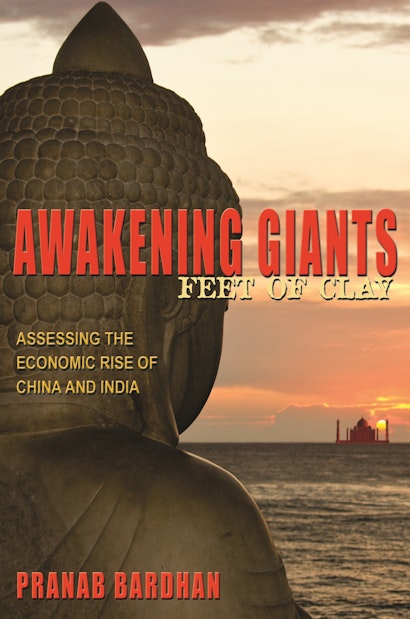The recent economic rise of China and India has attracted a great deal of attention—and justifiably so. Together, the two countries account for one-fifth of the global economy and are projected to represent a full third of the world’s income by 2025. Yet, many of the views regarding China and India’s market reforms and high growth have been tendentious, exaggerated, or oversimplified. Awakening Giants, Feet of Clay scrutinizes the phenomenal rise of both nations, and demolishes the myths that have accumulated around the economic achievements of these two giants in the last quarter century. Exploring the challenges that both countries must overcome to become true leaders in the international economy, Pranab Bardhan looks beyond short-run macroeconomic issues to examine and compare China and India’s major policy changes, political and economic structures, and current general performance.
Bardhan investigates the two countries’ economic reforms, each nation’s pattern and composition of growth, and the problems afflicting their agricultural, industrial, infrastructural, and financial sectors. He considers how these factors affect China and India’s poverty, inequality, and environment, how political factors shape each country’s pattern of burgeoning capitalism, and how significant poverty reduction in both countries is mainly due to domestic factors—not global integration, as most would believe. He shows how authoritarianism has distorted Chinese development while democratic governance in India has been marred by severe accountability failures.
Full of valuable insights, Awakening Giants, Feet of Clay provides a nuanced picture of China and India’s complex political economy at a time of startling global reconfiguration and change.
"[E]xcellent. . . . Bardhan writes with remarkable clarity about complex issues, such as the widely varying ways that corruption can affect the economy, and the positive as well as negative legacy of the Maoist era for China in terms of its recent trajectory. . . . He also shows some welcome stylistic flair, quoting poetry to good effect in one section (how often do economists do that?)."—Jeff Wasserstrom, Forbes.com
"Bardhan's refusal to shy away from complexity is refreshing, and it is this which distinguishes his book from many others in the field. . . . Although this is a book primarily focused on economics, it is not written solely for economists. It is a concise, accessible volume which can provide a valuable resource for anyone wanting to understand better the myriad complexities surrounding the rise of China and India."—Louise Merrington, China Journal
"Pranab Bardhan's Awakening Giants, Feet of Clay: Assessing the Economic Rise of China and India . . . succinctly summarizes the challenges facing China and India, including environmental degradation, unfavorable demographics, poor infrastructure, and social inequality—threats that the leaders of China and India understand. . . . A more contentious claim offered by Bardhan is that internal reform—not the global market—has been the key driver of both countries' growth."—Simon Tay, Foreign Affairs
"The strongest point in Bardhan's study is his insightful account of the role of democracy in promoting as well as hindering economic growth."—Nayan Chanda, BusinessWorld
"There is abundant literature on the comparative development of India and China, but most of it explains the difference in their growth rates on the macro level on ideological grounds: slower growth rate in democratic India versus faster development in authoritarian China. In this well-written and properly documented study, Bardhan examines growth in different sectors of the economies, particularly agriculture, industry, trade, infrastructure, savings, and investment rates. . . . This volume is an important reference for advanced students and researchers interested in the economic growth of these two Asian giants."—Choice
"Bardhan's book is a good place to understand the political economy of constraints the two economies are likely to face as they march ahead."—Siddharth Singh, Mint
"The author of this small volume is to be commended for packing so much useful information and analysis into such a short space."—Dwight H. Perkins, Developing Economies
"I welcome Bardhan's study as a splendid advance in the underdeveloped field of serious, detailed, analytical comparison of India and China. . . . This is a book that I will recommend to nonspecialist friends and happily assign to my undergraduates."—Thomas G. Rawski, Economic Development and Cultural Change
"Awakening Giants presents the author's perspective on the rise of India and China. It does it succinctly and in lively and engaging style. Bardhan's perspective is not one that everyone will share, but that is itself a compelling reason for recommending the book."—James Riedel, Perspectives on Politics
"Bardhan's exceptional work on India and China will be essential reading for graduate students and scholars who are interested in the political economy of India and China."—Alfred M. Wu, Journal of Chinese Political Science
"Pranab Bardhan is one of our most sophisticated thinkers on economic development. His skills are on display in this enormously insightful book. I cannot think of a better comparative guide to the rise of China and India."—Dani Rodrik, Harvard University
"Bardhan's book is erudite, informative, and accessible, and his scrutiny of the conventional wisdom about the past quarter century of reform in China and India is always provocative. You do not have to agree with him to be stimulated and rewarded by his insightful scholarship. This book deserves a wide audience."—Tarun Khanna, author of Billions of Entrepreneurs: How China and India Are Reshaping Their Futures, and Yours
"This book is an important reference for anyone interested in growth and poverty alleviation in China and India. It makes eye-opening comparisons and offers acute insights across such wide-ranging topics as poverty and inequality, labor and anticompetitive regulations, industrial concentration in India compared to other countries, electricity in Indian agriculture, Chinese financing of roads, and Indian and Chinese business-state relations."—Philip Keefer, World Bank


